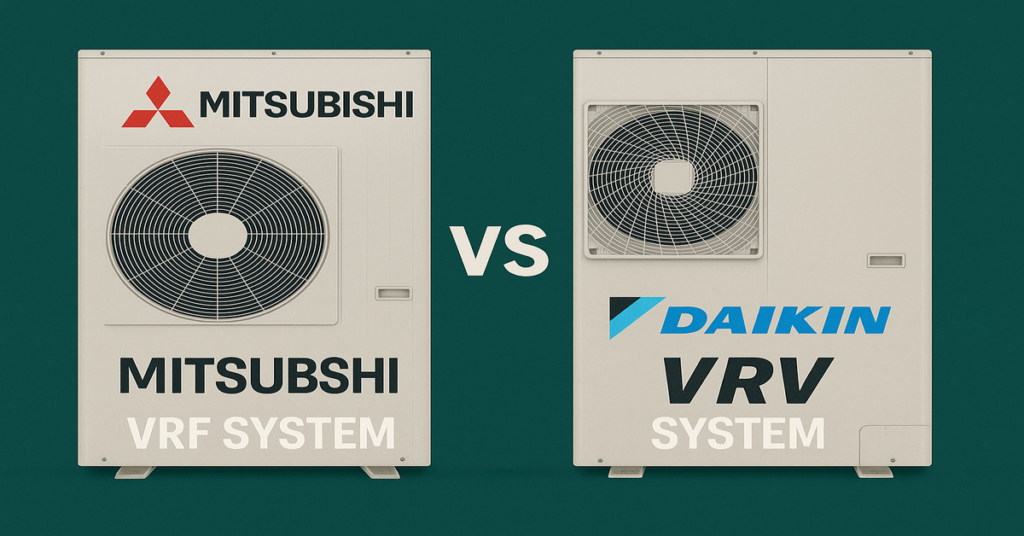
When choosing the right system for installing central air conditioning in Brooklyn, you need to think about more than just the brand. It has to do with making things work better, controlling the climate, making installation easier, and offering customer service. Both the Mitsubishi VRF and the Daikin VRV offer flexible options.
But there are important differences that need to be thought about carefully.
What are the components of Mitsubishi VRF and Daikin VRV Systems?
VRF (Variable Refrigerant Flow) and VRV (Variable Refrigerant Volume) are two names for the same technology. Daikin came up with the word VRV, however VRF became the standard nomenclature used by other manufactures, such Mitsubishi.
These systems use refrigerant to control the temperature in different parts of the house from one exterior unit. What is the main benefit? Using zoned climate control makes the system more energy efficient.
How well does Mitsubishi’s VRF technology work in real life?
Mitsubishi VRF is known for being accurate, quiet, and using less energy. This is why it works so well for homes in Brooklyn:
Adjust Zoning Flexibility:
Set the temperature for each room or region to your liking.
Energy Efficient:
Only changes the flow of refrigerant when necessary
Quiet Units:
Both the outdoor and indoor units work with very little noise.
Small Size:
Works great in brownstones or narrow multi-family homes
Quickly Changing Temperature:
This is especially helpful in New York, where the weather changes a lot.
Arnica Heating and Air Conditioning Inc. often installs Mitsubishi VRF systems in homes and commercial space, offering ongoing support and guidance.
What makes Daikin’s VRV System a strong competitor?
The way Daikin VRV systems work is different from other systems on the market. They do well in business settings because they have advanced controls and system intelligence. Here is what stands out:
Smart Technology: Changes automatically based on how many people are in the room and the weather.
Energy Management: Made to work well in many situations
Wide Range of Capacities: works well in tall buildings and wide open spaces
Integrated Redundancy: Makes sure that activities keep going smoothly even if a part fails.
Longevity: Built to last in tough, high-use settings
Daikin VRV is commonly used in businesses, co-working spaces, and schools in Brooklyn.
How well do these systems work when installed in place in Brooklyn?
Installation Procedure Mitsubishi VRF: Easier to install in tight spaces, less ducting needed
Daikin VRV system: The Daikin VRV system needs more planning and is better suited for bigger infrastructure projects.
Regulation and Zoning:
Mitsubishi: Mitsubishi is better for small-scale zoning, as for single-family homes or multi-family homes.
Daikin: Great for handling complicated zoning in big buildings
Financial Issues and Efficiency in Operations
Mitsubishi VRF: Lower beginning costs for smaller buildings
Daikin VRV: Better return on investment for large business initiatives over time
Help and Maintenance
Both brands offer long warranties and continuing service help. Arnica Heating and Air Conditioning Inc. says, though, that Mitsubishi’s system diagnostics make it easy to find and fix problems quickly.
Who Should Choose Mitsubishi VRF?
This system works well for:
- Brownstones and apartments that need ductless zoning
- Changes and improvements to ducting that does not meet the best requirements
- People who own homes and want to minimize their power bills by being aware of how much energy they use
Small Business Spaces with Different Rooms or Levels:
Who could benefit from Daikin VRV?
This system works best for:
- Buildings for business, including office buildings or stores
- Large homes with complicated HVAC needs
- Buildings with more than one story that need full climate control
- Properties that need advanced integration of building automation systems
Questions and Answers Section: Mitsubishi VRF vs. Daikin VRV
How do I decide between Mitsubishi VRF and Daikin VRV for my home?
First, think about the number of zones and the size of the area. Mitsubishi works well in homes with 8 to 10 zones. If you want a bigger setup or want to add to an existing structure, Daikin is the best choice.
Can these systems handle both heating and cooling?
Yes. Using heat recovery units, both systems can heat and cool different areas at the same time.
How long does it usually take to install central air conditioning in Brooklyn?
Most of the time, Arnica Heating and Air Conditioning Inc. can finish home installations in 3 to 5 days. It could take one to two weeks to finish bigger commercial projects.
Do you need to get permission to put in VRF/VRV systems in Brooklyn?
Yes. Getting the right permits for NYC is very important. Arnica’s team can help homeowners go through this process.
Do these systems need regular upkeep?
Sure. Maintenance every six months keeps the system running at its best and extends its life.
Which system has more features for improving indoor air quality?
Both have a filtration system with multiple stages. Plasma Quad filters are often included with Mitsubishi units to help manage allergens.
What is the final word for property owners in Brooklyn?
Choosing between Mitsubishi VRF and Daikin VRV depends on how much space you need, how you want to use it, and how much money you have. Mitsubishi is a good choice for small homes that need a certain level of comfort. Daikin is a good choice for big projects where performance and control are very important.
In either case, Arnica Heating and Air Conditioning Inc. does professional central air conditioning installation in Brooklyn, aiming to make the best system for each client’s needs.

Over 35 years of experienced HVAC engineer and blogger with years of experience writing about various topics related to multiple types of HVAC systems installation, repair, and maintenance. I have been in this industry since my apprenticeship in 1985. Our team emphasizes quality workmanship while ensuring customer satisfaction is our top priority.




0 Comments
1 Pingback